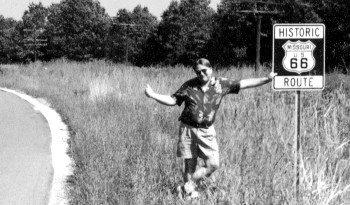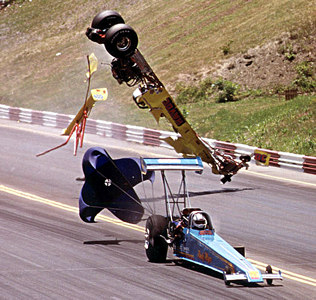 WHAT'S IT GONNA TAKE? Ed Note: This column was written and submitted late on Friday the 13th of October. On Saturday the 14th Top Fuel driver Wayne Bailey was killed at an IHRA National Event at Red River Raceway located approximately 20 miles from Shreveport, La. Bailey's Top Fuel car, a 1990 Gene Gaddy car, suffered chassis failure behind the driver. The weekend of the NHRA race at Memphis was one of the worst in my history of being involved in drag racing. Only the weekend when Blaine Johnson and Elmer Trett died at Indy was worse. Two young men that I know well, Tony Schumacher and Larry Dixon, had very bad crashes in Top Fuel cars and two funny racers that I don't know so well, Louis Sweet and Terry Haddock, had bad fires. To make matters worse, my friend Bill Kuhlmann had a very bad fire in his nitro coupe that put him in the burn center of a Virginia hospital and another racer I know well, Dave Uyehara, rolled a nostalgia Top Fuel car up in a ball at the Hot Rod Reunion. Luckily, very luckily, none of those guys were killed, but it could have easily happened, especially in the cases of Schumacher, Dixon and Kuhlmann. That realization has put me in a very black mood for the last several days because I believe that had there been any fatalities, at least part of the blame would have to be placed squarely on the shoulders of drag racing's sanctioning bodies and the people working for them. I know that what I'm about write is not going to make me any points with the sanctioning bodies or their employees, but I feel a moral obligation to try and motivate the people who control the sport I love to get off the dime and start making some decisions to protect the racers before we all end up talking about it at someone's funeral. First, let's talk about Top Fuel. These are 2150-lb cars that regularly exceed 300 mph in a quarter-mile. The cars and drivers both are regularly exposed to G-forces in the range of five, both plus and minus, on almost every pass. Top Fuel cars also have wings on either end of their 300-inch chassis, exerting around 5000 lbs of down-force at the rear and around 1000 on the front, which causes the chassis to bow in the middle during a run seriously stressing the chassis. (Just check out the "At the Back Door" photo this month.) So, let's understand that Top Fuel cars are the most dangerous vehicles on the planet. The names of racers who have had "blow-overs" or serious crashes caused by structural failure in Top Fuel cars reads like the line-up for an All-Star team. Don Garlits (twice), Eddie Hill, Don Prudhomme, Richard Holcomb, Jimmy Nix (twice), Paul Romine, and Gary Ormsby. To this day NHRA hasn't made wheelie bars mandatory despite the fact that more than one racer has saved himself and his car by having them. Just ask Jim Head, Butch Blair, or Jack Ostrander. Wheelie bars may not be the perfect solution, but having them is certainly better than not having them. If NHRA would require every Top Fuel car to run wheelie bars, there wouldn't be a problem. Is someone going to have to die in a blow-over accident before NHRA makes a decision? 
photo by Dave DeAngelis
Then there is the problem of wings. The development of wings on fuel cars is a very big factor in Top Fuelers ever getting to the four-second, 300-mph zone. That's the upside; the downside is that, according to every chassis builder I've talked to in the past few days, the bowing action caused by the down-force created by the wings literally tries to pull the chassis apart. Not only that, but the rear wings create about four times as much down-force as the front wings, which contributes to getting the front end off the ground. Why hasn't NHRA addressed this by drastically reducing wing size? It's not like these cars are ever going to approach or exceed elapsed times in the 4.40s or speeds over 330-mph on 90-percent nitro. Big wings are no longer needed, in my opinion, especially behind the rear tire. It's pretty obvious to even a casual observer that the combination of constant "bowing," excessive down-force at each end of the chassis, tire-shake, positive and negative G's each run, and tracks where the tires really hook up, is stressing chassis and wings to the max. And when a Top Fuel car has either chassis or wing failure the results are never good. In light of the serious accidents that drivers such as Gary Scelzi, Cory McClenathan, and Larry Dixon have had over the years due to chassis or wing failure, isn't it way past time for NHRA to put mandatory limits on how many laps a Top Fuel chassis can make before it has to be replaced? Or shall we just wait until someone is seriously injured or worse? Then there is the subject of repairing the chassis of a 300-mph fuel car between rounds. I talked to three NHRA chassis builders this week (who agreed to speak off the record for obvious reasons) about chassis repair. To a man they all said that any time the tubing on a chassis is bent - especially on a 300-mph Top Fuel car - it loses structural integrity and that portion of the chassis should be replaced. If NHRA officials knew that his chassis was straightened between rounds, how Larry Dixon was allowed to run his car at Memphis is a mystery to me. NHRA should immediately institute a rule which says, "If you tweak the chassis of any Pro Car during a race or qualifying, that chassis is disqualified." No exceptions. Perhaps NHRA should station a tech official in each pro pit on Sunday as NASCAR does to enforce or interpret rules and protect the racers from themselves. I've been told by chassis builders that there are stronger and better materials to build the chassis and components with, but that in some instances NHRA has not allowed those materials to be used because of the cost factor. I sincerely hope that is not the case. When building a 300-mph car that takes the stress a Top Fuel car does, money should be no object. Tony Schumacher's crash could easily cost that team $300,000-$400,000 when you consider that they destroyed a $125,000+ car and lost any chance to win the $200,000 they might have got for winning the Winston World championship. I hear a tab that attached Tony's wing to the wing struts may have failed because it was made of too brittle a metal and that there is an NHRA spec for that tab. I've also been told that there is a stronger material that the tab could have been built from but that NHRA disallowed the use of this material because of the cost. If this is true, what a shame! 
DRAG RACING Online will be published monthly with new stories and features. Some columns will be updated throughout the month. DRAG RACING Online owes allegience to no sanctioning body and will call ’em like we see ’em. We strive for truth, integrity, irreverence, and the betterment of drag racing. We have no agenda other than providing the drag racing public with unbiased information and view points they can’t read anywhere else except in the bathroom

 | | large editor/publisher | | | Jeff Burk | | editor at large | | | Chris Martin | | contributing editors | | | David Cook | | Dave Densmore | | Don Gillespie | | Jeff Leonard | | Jok Nicholson | | Geoff Stunkard | | John Raffa | | Dave Wallace
Ian Tocher | | technical editors | | Wady Hamam | | Ron Iskenderian | | Dave Koehler | | Jerry Haas | | Sky Wallace | | photographers | | | Jeff Burk | | Richard Brady | | Don Gillespie | | Ron Lewis | | Tim Marshall | Rollo Tomassi
Ian Tocher | | production manager | | | Kay Burk | | web / advertising coordinator | | | Casey Araiza | | |  | | head web wrench | | | Nathan Williams | | good mojo | | | Jef Waltman | | guru/president/race fan | | | Richard Burk | | generalissimo | | | Ellen Frattini | | NHRA needs to seriously re-evaluate its position when it comes to Top Fuel and Funny Cars in regards to safety. There is no doubt that both the NHRA and IHRA safety departments are constantly striving to make the cars and tracks safer, but judging from the history of crashes in just Top Fuel alone, they are failing. It is time for the sanctioning bodies to make some voluntary, drastic changes concerning how a fuel car is built before a catastrophic accident forces them to. If the crashes that happened in Top Fuel at Memphis had occurred at a track where the bleachers went to the finish line or beyond as they do at some NHRA venues, I shudder to think of what might have happened. Does anybody want to watch races behind 18-foot high fencing? NASCAR decided long ago that their cars were going too fast and they did something about it. It hasn't ruined that sport. The 90-percent nitro rule has slowed down the NHRA and IHRA cars and the fans don't seem to mind. Maybe it's time for the Top Fuel cars to get some chassis, wing and engine restrictions that will make the 300-mph pass the exception and not the rule. An occasional 300-mph pass is certainly more exciting than one after another, from an entertainment point of view. It is certainly time for NHRA to make the cars safer regardless of how fast they are going. If that means that teams have to spend another $20,000-$30,000 to build a car, so be it. That is less than they spend to build one complete engine. Engines and money are easier to come by than good people and drivers. Top Fuel driver Doug Foxworth, still recovering from his own IHRA Top Fuel dragster crash induced by chassis failure, asked me after watching the crashes of two of his fellow drivers, "What's it going to take before they (NHRA and IHRA) do something about this?" It's a good question. Next time I'll talk about fuel coupes and fire. photo by Kay Burk |